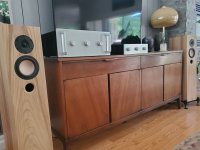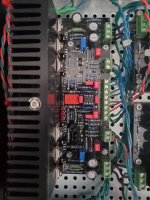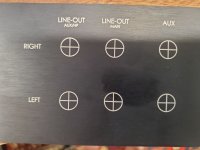Hi all.
I am yet to finish dcg3- been busy studying. Now finally free 🙂
In order to connect 2x18 from the transformer I need to connect two wires together -> CT, the remaining two will go to the AC parts of the terminal?
Thanks
I am yet to finish dcg3- been busy studying. Now finally free 🙂
In order to connect 2x18 from the transformer I need to connect two wires together -> CT, the remaining two will go to the AC parts of the terminal?
Thanks
Exactly. The near located inside wires when connected together set those secondaries in series, also creating a central tap reference point for symmetrical rectification.
You should read double the AC between the two free remaining wires vs between one free to CT.
You should read double the AC between the two free remaining wires vs between one free to CT.
Thank you and your efforts are well appreciated.Quite an impressive plan. Wishing you best of success with it.
In what system you listened to the #6915 conventional build?
At the moment the DCG3 is connected to 50W class A amp. It's actually an integrated with a B1 buffer that is bypassed at the rear connection panel.
The 2way speaker is my design.
Attachments
BTW we see some TO-92s in place of NEC UPA J1 J2 flat packs in #6,915. Are they 2SK170s? Also, what resistors are those abundant grey-bluish types? Tantalum?
I have another DCG3 ready for final build and had some etching done today. Same box/layout as in photo post 6,923
In Both units RZJ is a short and R15 is 49.9
I Layed out the rear so Headphone out(AUX/HP in attachment) can be used as headphone out or to drive another amp, so one or the other but not both.
If AUX/HP is used to drive another amp/speakers I would add resistance in the RCA cable --- Should I add 50 ohms??
Line out MAIN and Line out AUX/HP might be or might not be running at the same time!
For Headphone use I would simply run RCA's over to a diy headphone stand connected to the rear of the stand and wired to a female headhone jack at the front of the stand..
Thanks in advance
photo of the headphones and stands I just snipped off the internet.
In Both units RZJ is a short and R15 is 49.9
I Layed out the rear so Headphone out(AUX/HP in attachment) can be used as headphone out or to drive another amp, so one or the other but not both.
If AUX/HP is used to drive another amp/speakers I would add resistance in the RCA cable --- Should I add 50 ohms??
Line out MAIN and Line out AUX/HP might be or might not be running at the same time!
For Headphone use I would simply run RCA's over to a diy headphone stand connected to the rear of the stand and wired to a female headhone jack at the front of the stand..
Thanks in advance
photo of the headphones and stands I just snipped off the internet.
Attachments
If HP out is used to drive another line its better to make RZJ 49.9Ω too. The reason is to resistor buffer the two lines against interaction even when one connected is not active.
Another way is to keep HP minimum Z for connecting headphones only and branch out two R15s from the original line out point instead. So they Y out to a pair of line outputs.
Another way is to keep HP minimum Z for connecting headphones only and branch out two R15s from the original line out point instead. So they Y out to a pair of line outputs.
Dear Salas, I have a question on headphones.
I'll be using Grado GH4 ( https://gradolabs.com/headphones/limited-editions/item/109-gh4 )
Do you think the would need any resistor on RZ/J
Truth is that the would need some more punch than they already have....
I'll be using Grado GH4 ( https://gradolabs.com/headphones/limited-editions/item/109-gh4 )
Do you think the would need any resistor on RZ/J
Truth is that the would need some more punch than they already have....
For punch you don't want to add artificial output resistance in the amp. So to keep its damping factor high.
On the other hand if you want to warm the mid-bass of an enthusiastically open in mids & highs headphone then you can try 3.3Ω for the 32Ω Grado. That brand makes a loud transducer. You will not miss the 10% voltage loss by the resistors divider.
On the other hand if you want to warm the mid-bass of an enthusiastically open in mids & highs headphone then you can try 3.3Ω for the 32Ω Grado. That brand makes a loud transducer. You will not miss the 10% voltage loss by the resistors divider.
I currently have my DCG3 set to low bias (100mA). Heatsinks are cool. I have Rzj shorted and don't use the headphone out, just the line out via the 49.9R.
I have a new amp build under way, the Store M2X with the Edcor transformer for gain stage. This has a 600ohm primary. I understand that a low impedance is important to feed this and I also think I'm correct in saying the DCG3 has very low output impedance. The M2X has swappable input buffer boards (all unity gain) but I thought maybe the DCG3 can drive the Edcor directly.
Would it be worth increasing the bias current of the DCG3 for this ?
Edit...after all this just seeing section 9 of the build guide, 600R load gets 200mA drive whether 100ma or 150mA bias.....so I guess not worth it?!
I have a new amp build under way, the Store M2X with the Edcor transformer for gain stage. This has a 600ohm primary. I understand that a low impedance is important to feed this and I also think I'm correct in saying the DCG3 has very low output impedance. The M2X has swappable input buffer boards (all unity gain) but I thought maybe the DCG3 can drive the Edcor directly.
Would it be worth increasing the bias current of the DCG3 for this ?
Edit...after all this just seeing section 9 of the build guide, 600R load gets 200mA drive whether 100ma or 150mA bias.....so I guess not worth it?!
Jim hi,
100mA bias does the same for THD sweep as 150mA even on 80Ω headphones. Thus no objective improvement with more than 100mA bias if for a 600Ω load too. I had measured such situations. What you could compare is driving the Edcor directly from the raw headphones output vs from the line output. Meaning mΩ Zout vs 50Ω Zout. The 50Ω Zout is technically able even for 500Ω load with insignificant voltage loss because ten times smaller than such a load. But it will provide some damping vs the raw headphones output and you can subjectively compare the effect for preference.
Because the Edcor owes having inductance and parasitic capacitance, possibly an ultrasonic resonance too. Damping helps if rugged or just gets in the way if less rugged. Lets not forget the additional capacitance from the interconnecting cable existing before the Edcor too. Keep using the less fatiguing but still clean and punchy Zout/Edcor combination. If not completely happy with either way you can try small RzJ values for just right damping results with the Edcor. Like 5.6Ω 12Ω etc.
Female pin sockets for RzJ should make this easy and fun. You can replace the line out 50Ω resistor with your best value finding for the Edcor and return the headphones output to raw (jumper wire) in the end.
100mA bias does the same for THD sweep as 150mA even on 80Ω headphones. Thus no objective improvement with more than 100mA bias if for a 600Ω load too. I had measured such situations. What you could compare is driving the Edcor directly from the raw headphones output vs from the line output. Meaning mΩ Zout vs 50Ω Zout. The 50Ω Zout is technically able even for 500Ω load with insignificant voltage loss because ten times smaller than such a load. But it will provide some damping vs the raw headphones output and you can subjectively compare the effect for preference.
Because the Edcor owes having inductance and parasitic capacitance, possibly an ultrasonic resonance too. Damping helps if rugged or just gets in the way if less rugged. Lets not forget the additional capacitance from the interconnecting cable existing before the Edcor too. Keep using the less fatiguing but still clean and punchy Zout/Edcor combination. If not completely happy with either way you can try small RzJ values for just right damping results with the Edcor. Like 5.6Ω 12Ω etc.
Female pin sockets for RzJ should make this easy and fun. You can replace the line out 50Ω resistor with your best value finding for the Edcor and return the headphones output to raw (jumper wire) in the end.
Hi Nic. Great in depth reply thankyou. I have learned a lot since building my DCG3 and can see the schematic shows me how the outputs, be it 50R or link wire RzJ can work and so yes I can try your suggestions. Brilliant. Obviously I will try the M2X with buffer but would like to try pure DCG3 to Edcor also.
As words of encouragement: DCG3 + M2X monos was the staple in my system for years (vinyl centric, but full family movie duties too). Excellent combo—playing with all the M2X stages was/is insanely fun. (Power amps have moved around—DCG3 hasn't moved!)
While every Salas’ advice regarding line transformer driving is correct, I had great results with direct driving VAS transformer at M2X close cousin - LuDEF, without any damping resistor. I got extended frequency response and lower distortion, with very clean harmonic profile.
https://www.diyaudio.com/community/threads/ludef.369990/post-6845895
https://www.diyaudio.com/community/threads/ludef.369990/post-6845895
Thabks guys for those further replies. All interesting. Indeed I have kept DCG3 in place the whole time but I do try different power amps.!
Maybe the transformer has Zobel termination (RC) across its secondary? THD still rises towards 20kHz in your link nonetheless.While every Salas’ advice regarding line transformer driving is correct, I had great results with direct driving VAS transformer at M2X close cousin - LuDEF, without any damping resistor. I got extended frequency response and lower distortion, with very clean harmonic profile.
https://www.diyaudio.com/community/threads/ludef.369990/post-6845895
- Home
- Source & Line
- Analog Line Level
- Salas DCG3 preamp (line & headphone)



